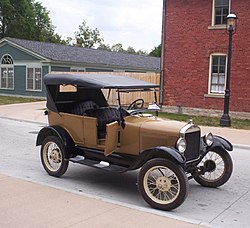Antique car
An antique car is generally defined as a car over 25 years of age, this being the definition used by the Antique Automobile Club of America and many other organizations worldwide. However, the legal definition for the purpose of antique vehicle registration varies widely.
The term classic car is often used synonymously with antique car, but the formal definition Template:Fact of that term has it as applying only to certain specific high-quality vehicles from the pre-World War II era.
25 years is about double the design life of modern cars and an even greater increment on those cars now 25 years old; therefore, a car that's reached 25 is a rare survivor, and probably not economic to maintain as regular transportation.
Owning, restoring and collecting antique cars is a popular hobby worldwide.
Considered as investments
Some consider such collectables be a form of investment. Buying a particular antique car is then done primarily in view of profit in a future sale and not of enjoying a drive or taking pleasure in restoration work. As with art collecting, antique car collecting is another form of gambling. The market for antique cars fluctuates wildly over the years. There have been periods, like the 1980s, which have seen strong and continued increase in price, but other periods (e.g. the early 1990s) which saw precipitous declines.
Template:Globalize Experts in antique cars such as Jay Leno give the same advice as serious art dealers and professionals in the antiques trade: Collect what you can enjoy above all because the future monetary value of any craft or art object is completely unpredictable. Still, the other opinion and plan exists: Person's living in naturally dry areas such the South Western Desert region, can approach this as a potential long term investment, due to the lesser chance of destruction of the bodies by rusting. One strategy requires that you buy a car that is in good condition with original paint and chrome in good order. It should be purchased for less than $500 in good running condition, with no broken glass and low mileage. The car should be at least 20 years old. This seems to be the time when the value of the car "bottoms out". A person needs to have at least 20 of these $500 cars. Parked on blocks, with the glass masked to prevent wind/sand damage. No more than $100 per car per year should go to provide the outdoor storage in the first year. The cars should be started up once every 3 months. 20 cars would cost $2000 the first year in storage. By waiting 20 years, the cars might be worth in adjusted dollars, 20 times or more than when parked. Constant dollar $500 cars might become constant dollar $10,000 cars after 20 years, if long term trends continue... as 99.9% of the same models will be junked, under all normal uses... Rarity is a key basis of value, and the rest is about the innate charm of the car, and its reflection of the era it represents. A 20 fold increase in constant value is much better than most 20 year investments.
Value
As with all collectible antiques, current value is everything to do with current supply vs. demand, and very little else; certainly little to do with the car's price when new or any objective standard. Thus, rare cars that are highly desired are highly expensive, while vehicles that are not fashionable to collect can be very cheap. Condition, of course, influences value. At the present time, the variation in purchase price between a poor condition and good condition vehicle is generally much less than the cost of restoring a poor condition car; thus it is cheaper in the long run to buy the better vehicle.
In some instances, professional restorers can, through economy of scale and performing the work in-house, realise a profit from buying an unrestored car and performing a restoration. This is normally only possible when the car is in high demand and either very rare (e.g. old Ferraris) or quite common (e.g. classic Ford Mustangs). Amateur restorers who are highly skilled may find it cheaper to restore than buy in good condition, but this is through considering their labor enjoyment rather than a cost.
Realising much long-term profit in owning an antique car is mostly about attempting to anticipate future changes in taste, which is highly speculative. Most cars go through a period of being considered merely old and undesirable before becoming valuable, and a car bought then might drastically increase in value. However, a car is a large object that is expensive to store and must be maintained, which cuts into such profits.
